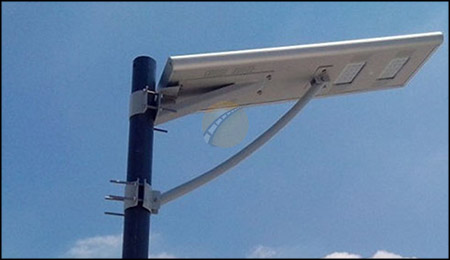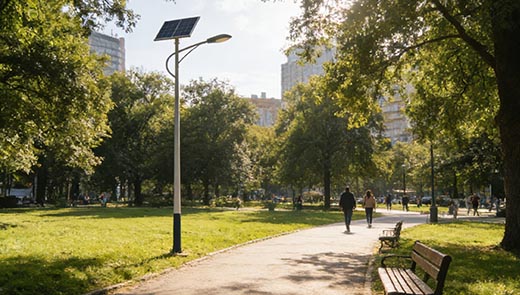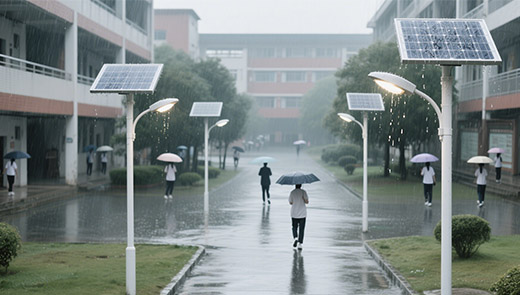How to Choose Solar Street Light Color Temperature
In the construction of urban infrastructure and outdoor public space, the color temperature of solar street light is a key factor that affects the lighting effect, safety and environmental atmosphere. Reasonable color temperature setting can not only improve lighting efficiency, but also play an important role in energy saving, safety and aesthetics. The following is an in-depth analysis of the color temperature of solar street lights from multiple dimensions.
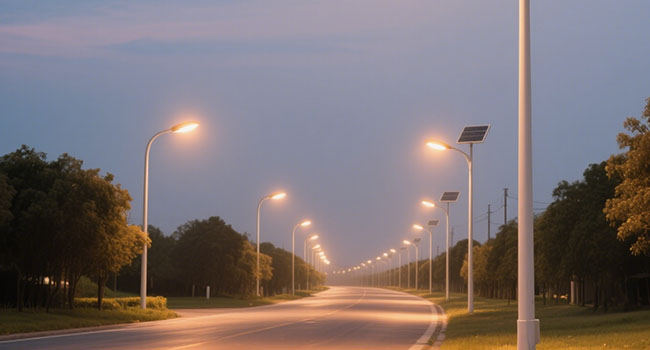
What is LED Light Temperature?
LED light color temperature is an important indicator of the color appearance of the light emitted by the lamp, in Kelvin (K) units. This concept originates from the theory of blackbody radiation, blackbody at different temperatures will emit different colors of light, this color and temperature correspondence is applied to describe the color characteristics of LED light. A low Kelvin value means that the light is inclined to warm yellow tones, and as the value rises, the light gradually transitions to white, blue-white, and presents cooler tones.
By controlling the color temperature, we are able to create diverse lighting atmospheres. For example, in a warm living environment, low color temperature light can bring a comfortable and relaxing feeling; while in the need for clear vision of the workplace or traffic, high color temperature light can provide bright and clear lighting effect. Understanding the nature and characteristics of LED light color temperature is the basis for choosing the correct color temperature for solar street lights.
Types of LED Light Temperatures for Solar Street Lights
Warm White (2700-3000K)
Warm white light conveys a sense of warmth, serenity and intimacy, and is commonly used for indoor lighting in homes and commercial establishments. Its short wavelength of yellow light provides excellent penetration in rainy weather, but its low visibility is a significant drawback. For example, in the lighting of neighborhood alleys, warm white light can create a warm atmosphere, but it is difficult for pedestrians to clearly identify the details of objects in the distance.
Natural Light (3000K - 4500K)
LED light in this range is known as neutral light, bright and vibrant, ideal for basements, factories, hospitals and other workplaces. Of these, 4000 - 4500K is the closest to natural light, with a soft glow that keeps drivers focused while providing a high level of brightness. However, it is slightly less visible than lights above 5000K.
Cool White Light (4500K - 6500K)
Cool white light resembles sunlight and excels in scenes that require high intensity lighting, such as security lighting, display cases, warehouses and industrial areas. Lights above 5700K, in particular, are popular for engineering projects due to their high visibility, which reduces the incidence of accidents. However, prolonged exposure to this type of light can cause visual fatigue, making it unsuitable for long-term workspaces.
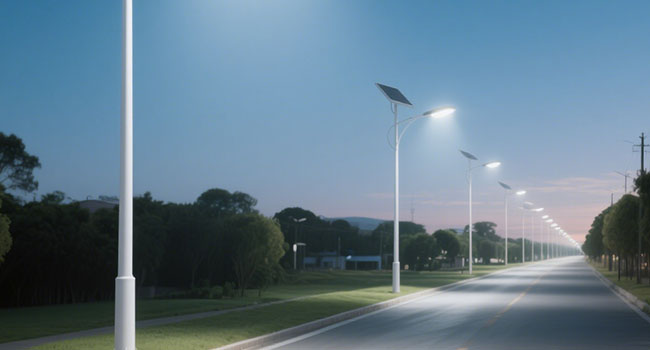
Why Color Temperature Matters
Visibility and Safety
The core objective of outdoor lighting is to provide clear visibility and safety for pedestrians and vehicles, and different color temperatures play a key role in making a difference. Cool white light, with its high brightness and high contrast, performs well in heavy traffic, main roads and areas of high safety demand. For example, around highways and large transportation hubs, this light allows drivers to spot road signs, vehicle dynamics ahead, and potential obstacles in a timely manner, effectively enhancing nighttime driving safety.
Neutral white light is suitable for commercial and residential areas, its light is soft and moderate brightness, not only to meet the lighting needs of commercial areas, clear display of goods and architectural appearance, but also in residential areas to achieve a balanced and stable lighting, to avoid too strong or too dark light affecting the lives of residents. Warm white light is more suitable for places with low traffic flow and focus on landscape atmosphere, such as park trails and quiet residential streets, which can meet the basic lighting needs while creating a warm and peaceful atmosphere, so that pedestrians can also feel comfortable and cozy at night.
Energy Efficiency
The LED technology used in the solar led street light itself has high energy efficiency. Compared with traditional incandescent and fluorescent lighting systems, LED lights are able to convert more electrical energy into light energy and reduce energy loss. In terms of the relationship between color temperature and energy efficiency, although cool white light needs to consume more energy in order to achieve high brightness, solar LED street lights can maximize energy efficiency while maintaining high brightness illumination through advanced design and technical optimization.
For example, some solar street lights use intelligent dimming technology to automatically adjust the light brightness and color temperature according to the ambient light intensity and actual demand. When there are fewer pedestrians or vehicles at night, the light brightness and color temperature are appropriately lowered to reduce energy consumption; while during busy traffic hours, the brightness and color temperature are raised to protect the lighting effect. This intelligent design enables the solar street light to achieve efficient energy utilization under different color temperature settings, further reflecting its energy-saving advantages.
Aesthetic Appeal
Color temperature plays a decisive role in shaping the atmosphere of an area. Warm white light creates a relaxing and cozy environment; neutral white light creates a natural and realistic visual impression that complements the urban environment; and cool white light is more functional and suitable for areas where safety and visibility are critical.
How to Choose the Right Color Temperature?
Comfort
The eyes of human beings and small animals have different perceptions and reactions to light sources with different color temperatures. Warm light (around 3000K) relaxes the mind and body, reduces stress and creates a cozy and comfortable atmosphere. This type of light is less irritating to the human eye, and prolonged exposure to this type of light is less likely to cause eye fatigue.
On the contrary, although the cool-toned light (around 6500K) can provide bright and clear lighting, it sometimes makes people feel that the light is too harsh and cold, and prolonged exposure to this kind of light will easily lead to eye fatigue, dryness, and may even affect people's mood and sleep quality. Therefore, when choosing the color temperature of road lighting, the visual comfort of the human eye must be fully considered, especially in residential areas, parks and other places where people stay and move around for a long time.
In addition, different animals have different responses to light color temperature. For example, some birds and insects are more sensitive to specific wavelengths of light, and inappropriate color temperature may interfere with their normal habits and behavior. In ecologically protected areas or areas with a lot of wildlife activity, choosing the right color temperature for lighting is also important for biodiversity conservation.
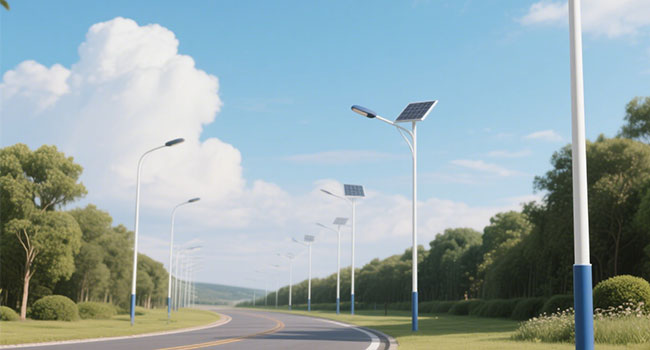
Pedestrian Safety
One of the core objectives of roadway lighting is to provide a safe environment for pedestrians and vehicles. Light with a low color temperature (e.g. 3000K) creates a warm atmosphere, but in low light conditions, its low visibility may affect the recognition of colors and details of objects in the surrounding environment. For example, at night, pedestrians may find it difficult to clearly distinguish obstacles on the road, the color of vehicles and driving status, increasing the risk of accidents.
And while high color temperature (above 6000K) light can provide good visibility under normal weather conditions, new problems can arise during inclement weather such as rain or snow. As high color temperature light has more blue light components, when encountering snow or water on the ground, the light will be reflected into a blue-violet color, and this reflected light will interfere with the visual judgment of pedestrians and drivers, resulting in blurred vision and increasing the probability of traffic accidents. Therefore, when choosing the color temperature of solar street lights, we must consider the visual safety needs under different weather conditions to ensure the safety of pedestrians and vehicles.
Geographical Latitude
Geographical latitude has an important impact on people's living environment and climatic conditions, which in turn also affects people's preference for the color temperature of solar street lights. In high latitude areas, such as Northern Europe, Russia and other countries and regions, due to the cold climate, long winters and low temperatures bring a lot of inconvenience to people's lives. In such an environment, people are more inclined to choose warm color temperature lights, because the warm white light can bring a warm feeling, relieve the discomfort caused by the cold climate, and create a warm living atmosphere for people.
In low latitudes, near the equator of the countries and regions, such as Southeast Asia, parts of Africa, etc., the year-round high temperatures, hot climate. In these areas, people are more eager to cool feeling, so high color temperature cool white light is more popular. Cool white light can give people a fresh, cool visual feeling, to a certain extent, to alleviate the hot emotions brought about by high temperatures. On the contrary, low color temperature lighting in hot climates can be more depressing and irritating, affecting people's life experience.
Road Lighting Color Temperature Illumination Ranges
Highway Lighting CCT
Some countries specify that the color temperature of highway lighting should not exceed 5000K, and recommend the use of medium-low color temperature. However, in actual projects, high color temperatures of 5700K or even 6000K are widely used. This is because high color temperature can significantly improve visibility and reduce traffic accidents, although there is a certain visual fatigue problem, but in the protection of traffic safety advantages are more prominent.
Color Temperature Requirements for Airport Road Lighting
According to the technical standards for civil airport flight zones, when LEDs are used as a light source, lenses must be added to control glare and the color temperature must not exceed 4000 K. This requirement is designed to ensure the quality of lighting on roads around airports, avoiding light interference with pilots and ground crews, and guaranteeing the safety of air transportation.
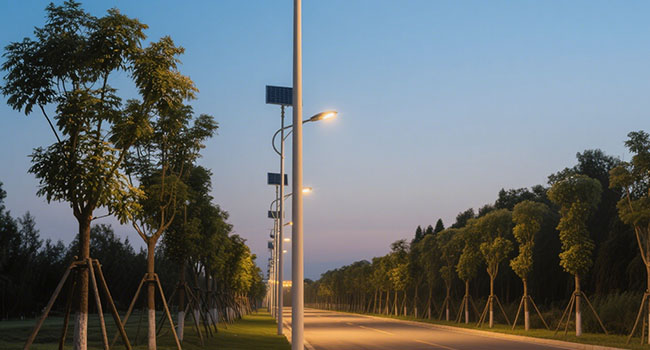
Residential Area Road Lighting CCT
For roads in residential areas with a mix of motorized traffic and pedestrians, it is appropriate to use light sources with low to medium color temperatures, and in most cases, the color temperature is usually kept below 4000K. Such a setting can meet the lighting requirements and minimize the impact on the residents' nighttime rest, creating a quiet and comfortable living environment.
Color Temperature Requirements for Roads with Rain and Fog
Along rivers and foggy roads, it is recommended to use low color temperature lights with a color temperature range of 2700K - 3500K. The low color temperature light has strong penetration and can better illuminate the road in rain and fog, allowing drivers and pedestrians to see the road ahead, effectively reducing the risk of traveling in inclement weather.
Commercial Area Road Lighting Color Temperature
In busy commercial areas, historical and cultural districts, scenic spots and other places, motor vehicle traffic color recognition is more important, so it is suitable for the use of high color rendering index (CRI), low to medium color temperature of the light source. This type of light source can accurately reproduce the color of goods and buildings, show the commercial atmosphere and landscape features, and attract the attention of consumers.
Parking Lot Road Lighting CCT
The color temperature of parking lot lighting is 5700 - 6500 K. A color temperature of 5700 K helps drivers to focus their attention, clearly identify parking spaces and surrounding vehicles, and improves driving safety to ensure that vehicles in the parking lot are driven and parked in a safe and orderly manner.
Color Temperature Requirements for Garden and Industrial Lighting
Spotlights and outdoor floodlights used for landscape lighting in gardens are generally more suitable for warmer tones of 2700K and 3000K, creating a warm, relaxing atmosphere and a pleasant viewing experience for visitors. Industrial lighting needs to choose the right color temperature according to the specific industrial production scenes and needs, in order to meet the special requirements of the working environment on the lighting, to ensure the smooth progress of production activities.
The selection of color temperature for solar street light is a comprehensive work, which needs to fully consider the visibility, safety, energy efficiency, aesthetics, use of the scene, geographical latitude and other factors. Different color temperature types have their own characteristics and scope of application, only by combining the lighting objectives and needs of specific scenes, can we make the most reasonable decisions to achieve the optimization of the solar street light lighting effect, and provide a safe, comfortable and efficient lighting environment for the city and outdoor space.

